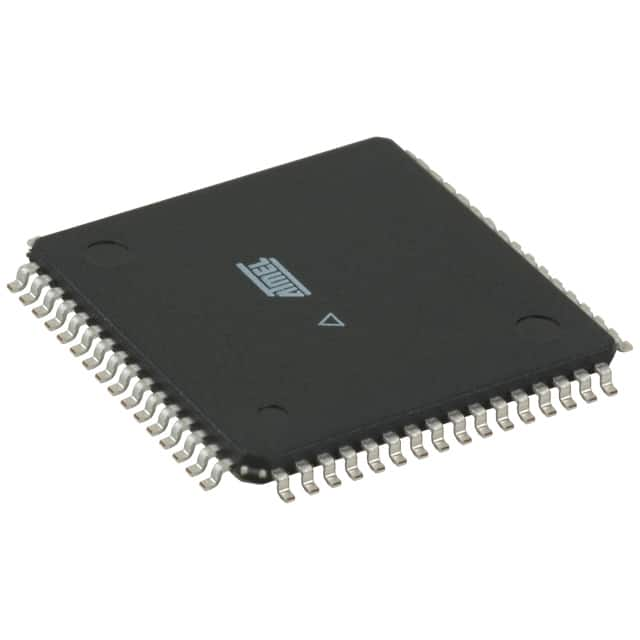Lihat spesifikasi untuk detail produk.

ATMEGA103L-4AI
Product Overview
Category
ATMEGA103L-4AI belongs to the category of microcontrollers.
Use
It is commonly used in various electronic applications that require a microcontroller for processing and controlling functions.
Characteristics
- Low-power consumption
- High-performance
- Versatile functionality
- Robust design
Package
ATMEGA103L-4AI is available in a compact package, suitable for integration into different electronic devices.
Essence
The essence of ATMEGA103L-4AI lies in its ability to provide efficient and reliable control and processing capabilities in electronic systems.
Packaging/Quantity
ATMEGA103L-4AI is typically packaged in trays or reels, with varying quantities depending on the manufacturer's specifications.
Specifications
- Microcontroller architecture: AVR
- Operating voltage: 2.7V to 5.5V
- Clock frequency: Up to 16 MHz
- Flash memory: 128 KB
- RAM: 4 KB
- EEPROM: 4 KB
- Number of I/O pins: 53
- Communication interfaces: UART, SPI, I2C
- Analog-to-Digital Converter (ADC): 8 channels, 10-bit resolution
- Timers/Counters: 3 timers/counters
Detailed Pin Configuration
The pin configuration of ATMEGA103L-4AI is as follows:
- VCC
- GND
- Port A0
- Port A1
- Port A2
- Port A3
- Port A4
- Port A5
- Port A6
- Port A7
- Port C0
- Port C1
- Port C2
- Port C3
- Port C4
- Port C5
- Port C6
- Port C7
- Port D0
- Port D1
- Port D2
- Port D3
- Port D4
- Port D5
- Port D6
- Port D7
- Port B0
- Port B1
- Port B2
- Port B3
- Port B4
- Port B5
- Port B6
- Port B7
- RESET
- XTAL1
- XTAL2
- AVCC
- AREF
- GND
- ADC0
- ADC1
- ADC2
- ADC3
- ADC4
- ADC5
- ADC6
- ADC7
- SDA
- SCL
- MOSI
- MISO
- SCK
Functional Features
- High-speed processing capabilities
- Multiple communication interfaces for data exchange
- Analog-to-Digital Converter for sensor interfacing
- Timers/Counters for precise timing and event control
- GPIO pins for general-purpose input/output operations
- Low-power consumption modes for energy efficiency
Advantages and Disadvantages
Advantages
- Versatile functionality suitable for a wide range of applications
- Robust design ensures reliability in demanding environments
- Low-power consumption extends battery life in portable devices
- Ample memory capacity for storing program code and data
- Extensive I/O options for interfacing with external components
Disadvantages
- Relatively higher cost compared to simpler microcontrollers
- Steeper learning curve for beginners due to advanced features
- Limited availability of alternative models from other manufacturers
Working Principles
ATMEGA103L-4AI operates based on the AVR microcontroller architecture. It executes instructions stored in its flash memory, processes data, and controls external devices through its I/O pins. The clock frequency determines the speed at which instructions are executed. Communication interfaces enable data exchange with other devices, while timers/counters provide precise timing and event control. The ADC allows analog signals from sensors to be converted into digital values for processing.
Detailed Application Field Plans
ATMEGA103L-4AI finds applications in various fields, including but not limited to:
- Industrial automation
- Consumer electronics
- Automotive systems
- Medical devices
- Internet of Things (IoT) devices
- Robotics
- Home automation
- Security systems
Detailed and Complete Alternative Models
While ATMEGA103L-4AI is a reliable microcontroller, there are alternative models available from other manufacturers that offer similar functionality. Some notable alternatives include:
- PIC18F4550 by Microchip Technology
- STM32F407 by STMicroelectronics
- LPC1768 by NXP Semiconduct
Sebutkan 10 pertanyaan dan jawaban umum terkait penerapan ATMEGA103L-4AI dalam solusi teknis
Sure! Here are 10 common questions and answers related to the application of ATMEGA103L-4AI in technical solutions:
Q: What is ATMEGA103L-4AI? A: ATMEGA103L-4AI is a microcontroller from Atmel, now Microchip Technology, which is commonly used in various technical solutions.
Q: What are the key features of ATMEGA103L-4AI? A: Some key features of ATMEGA103L-4AI include 8-bit AVR architecture, 4KB EEPROM, 128KB Flash memory, 4-channel 10-bit ADC, and multiple communication interfaces.
Q: What are the typical applications of ATMEGA103L-4AI? A: ATMEGA103L-4AI is commonly used in applications such as industrial control systems, home automation, robotics, automotive electronics, and consumer electronics.
Q: How can I program ATMEGA103L-4AI? A: ATMEGA103L-4AI can be programmed using various programming languages like C or assembly language. You can use development tools like Atmel Studio or Arduino IDE for programming.
Q: Can ATMEGA103L-4AI communicate with other devices? A: Yes, ATMEGA103L-4AI supports multiple communication interfaces like UART, SPI, and I2C, allowing it to communicate with other devices such as sensors, displays, and external memory.
Q: What is the operating voltage range of ATMEGA103L-4AI? A: The operating voltage range of ATMEGA103L-4AI is typically between 2.7V and 5.5V.
Q: Does ATMEGA103L-4AI have any built-in peripherals? A: Yes, ATMEGA103L-4AI has built-in peripherals like timers/counters, PWM channels, interrupt controllers, and GPIO pins.
Q: Can I use ATMEGA103L-4AI in battery-powered applications? A: Yes, ATMEGA103L-4AI is suitable for battery-powered applications as it has low power consumption features like sleep modes and power-saving techniques.
Q: Is ATMEGA103L-4AI compatible with other microcontrollers? A: ATMEGA103L-4AI follows the AVR instruction set architecture, making it compatible with other AVR microcontrollers. However, compatibility with other microcontroller families may require additional considerations.
Q: Where can I find technical documentation and resources for ATMEGA103L-4AI? A: You can find technical documentation, datasheets, application notes, and other resources for ATMEGA103L-4AI on the official Microchip Technology website or through various online electronics communities and forums.

